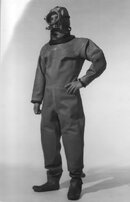Sorry for my ignorence when you mean "bounce" you mean to touch the mark and take off, kind of taking a selfy on a plase to let know you been there, right ?
Not exactly, but close in this case. The term “bounce dive” in the commercial diving industry is one where the bottom time is less than is required for full saturation. See What is Saturation Diving — which was in the early experimental stages in 1962.
In practice, the total dive times (leave surface to leave bottom) were usually under an hour and typically in the 200-600' range. In some areas of the world a “bounce dive” can mean any surface supplied or Scuba dive less than 24 hours where other places use it to describe a short duration dive made with a diving bell and deck chamber.
I have heard the term used in recreational diving to describe what can be called a “touch and go” dive like grabbing a depth marker tag on a descent line or a hand full of mud.
… Certainly a milestone in diving, but ill prepared which cost the lives of three Englishmen.
I was there as a spectator. Were you?...
No, but I remember it well. That dive was on my twelfth birthday. That was my first real lesson on how the media can totally screw up a report.
Three Englishman? I know about Keller’s bellmate Peter Small and the support diver Chris Whittaker but don’t recall a third. I read several Navy reports in the early 1970s on the Keller dive in the library at Submarine Development Group One. The article in Skin Diver Magazine (February 1963) written by Paul Tzimoulis was probably the best publically available description at the time.
The most thorough discussion I have seen is in Christopher Swann’s The History of Oilfield Diving: An Industrial Adventure. Chapter 8, Hannes Keller and His Secret Mixtures, even includes the gas mixtures used.
---------- Post added October 3rd, 2014 at 12:45 PM ----------
Sam
I was thinking about your “ill prepared” comment a little more, “under-funded” is probably more accurate. Keller and Bühlmann were on a shoe string budget and had no operational experience. Errors that seem obvious even to recreational Scuba divers experienced in such a benign area as Catalina were unknown to this Swiss mathematician who had been very deep a few times in Alpine lakes and in University chambers.
Even if they had the budget and at-sea experience, there would still have been Helium leaks, which was the root cause of the problems. Sealab was leaking badly a little more than 6 years later with the most experienced HeO2 divers in the world and on their third mission. Keller’s exposure protection and breathing systems were grossly inadequate… just like Sealab III. Finally, their knowledge of HPNS (High Pressure Nervous Syndrome) was rudimentary at best in those days.
Every early deep dive was ill prepared because it was a pioneering effort. The US Navy’s Sealab III, where Barry Cannon died, was well funded but also horribly ill prepared. Their problem was the project was way too rushed, which is often a problem on big-budget operations. Not nearly at the same pioneering level, but we were still constantly learning important and deadly lessons years later during the 1970s and 80s.
Thanks to all the pioneers that preceded me, living and dead.
Last edited:





